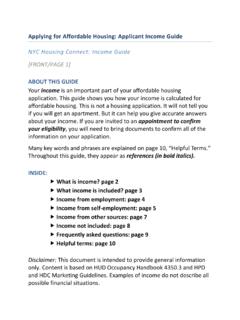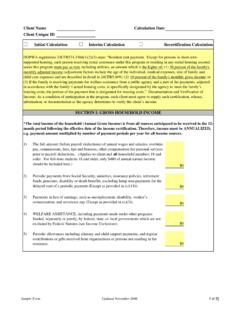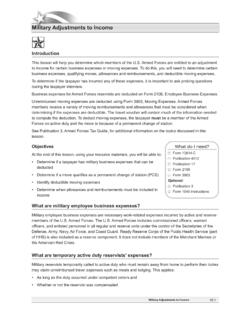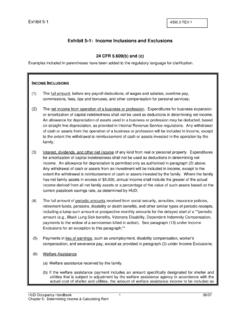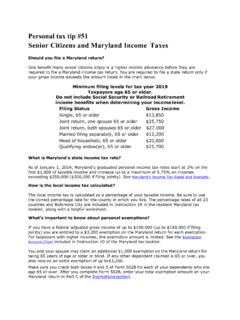Transcription of The Use of Modified Adjusted Gross Income (MAGI) in ...
1 The Use of Modified Adjusted Gross Income (MAGI) in Federal Health Programs Updated December 6, 2018 Congressional Research Service R43861 The Use of Modified Adjusted Gross Income (MAGI) in Federal Health Programs Congressional Research Service Summary Certain portions of federal health programs rely on means testing for eligibility and other purposes. Medicare premiums, the individual mandate exemptions and penalties, eligibility and amounts for tax credits for health insurance exchange coverage, and Medicaid eligibility are determined, in part, using Modified Adjusted Gross Income (MAGI). MAGI is a concept that is used throughout federal tax law and certain federal programs. There is no uniform definition of MAGI; rather, the term has different definitions depending on the purpose for which it is being calculated. For each of these federal health programs, MAGI begins with Adjusted Gross Income (AGI) as calculated for tax purposes. From there, various types of Income are included (or, in the case of Medicaid, subtracted) to calculate MAGI for each particular program.
2 The different health programs do not necessarily define household Income using the same groupings of people. For example, married couples living together are counted as the same Medicaid household regardless of whether they file a joint tax return. By contrast, married couples must file a joint tax return to be eligible for premium credits. The Patient Protection and Affordable Care Act (ACA; 111-148, as amended) established Section 36B of the Internal Revenue Code (IRC) to authorize a tax credit to assist eligible taxpayers with the purchase of coverage through health insurance exchanges. Household Income is used, among other factors, to determine eligibility for and amount of the premium tax credit. IRC Section 36B includes a definition of household Income , which is calculated using the MAGI amount (subject to certain adjustments) for eligible taxpayers and tax dependents. The MAGI definition in IRC Section 36B also is used as a basis in determining (1) whether an individual is exempted from the individual mandate, (2) the penalty amount owed if a person does not comply with the individual mandate, and (3) Medicaid Income eligibility for certain populations.
3 However, in each case the MAGI definition in IRC Section 36B is Modified differently. Finally, a MAGI definition that differs from that in IRC Section 36B is used to determine which Medicare beneficiaries pay high- Income premiums. This report explores the different MAGI definitions across health programs, including Medicare, the individual mandate, premium tax credits on the health insurance exchanges, and Medicaid. It also addresses why MAGI is used and how it is applied, specific to each program. The Use of Modified Adjusted Gross Income (MAGI) in Federal Health Programs Congressional Research Service Contents Introduction .. 1 Definition of MAGI in Health Programs .. 1 Medicare Income -Related Premiums .. 4 Determination of Income .. 5 Individual Mandate .. 6 Determination of Income .. 6 Exchanges and Premium Tax Credits .. 7 Determination of Income .. 8 Medicaid .. 9 Determination of Income .. 9 Transition to MAGI .. 10 How MAGI Is Applied in Medicaid .. 10 MAGI-Exempted Groups.
4 11 Countable Income .. 11 Family Size and Total Household Income .. 12 Tables Table 1. Additions and Subtractions to Federal Adjusted Gross Income (AGI) to Calculate Modified Adjusted Gross Income (MAGI) for Health Programs .. 2 Table A-1. Medicaid MAGI-Based Eligibility Categories, Beginning January 1, 2014 .. 14 Table A-2. MAGI-Excepted Eligibility Categories, Beginning January 2014 .. 15 Appendixes Appendix. MAGI and Medicaid s Eligibility Categories .. 14 Contacts Author Information .. 19 Acknowledgments .. 19 The Use of Modified Adjusted Gross Income (MAGI) in Federal Health Programs Congressional Research Service R43861 VERSION 11 UPDATED 1 Introduction Certain portions of federal health programs rely on means testing for eligibility and other purposes. Medicare premiums, the individual mandate exemptions and penalties, eligibility and amounts for tax credits for health insurance exchange coverage, and Medicaid eligibility are determined, in part, using Modified Adjusted Gross Income (MAGI).
5 MAGI is a concept that is used throughout federal tax law and certain federal programs. However, there is no uniform definition of MAGI; rather, the term has different definitions depending on the purpose for which it is being calculated. For each of these federal health programs Medicare, the individual mandate, premium tax credits on the health insurance exchanges, and Medicaid MAGI begins with Adjusted Gross Income (AGI) as calculated for tax purposes. From there, various types of Income are included (or, in the case of Medicaid, subtracted) to calculate MAGI for each particular program. In addition, the different health programs do not necessarily define household Income using the same groupings of people. For example, married couples living together are counted as the same Medicaid household regardless of whether the married individuals file a joint tax return. By contrast, married couples must file a joint tax return to be eligible for premium credits. The Patient Protection and Affordable Care Act (ACA; 111-148, as amended) established Section 36B of the Internal Revenue Code (IRC) to authorize a tax credit to assist eligible taxpayers with the purchase of coverage through health insurance exchanges.
6 Household Income is used, among other factors, to determine eligibility for and amount of the premium tax credit. IRC Section 36B includes a definition of household Income , which is calculated using the MAGI amount (subject to certain adjustments) for eligible taxpayers and tax dependents. The MAGI definition in IRC Section 36B also is used as a basis in determining (1) whether an individual is exempted from the individual mandate, (2) the penalty amount owed if a person does not comply with the individual mandate, and (3) Medicaid Income eligibility for certain populations. However, in each case the MAGI definition in IRC Section 36B is Modified differently. Finally, a MAGI definition that differs from that in IRC Section 36B is used to determine which Medicare beneficiaries pay high- Income premiums. This report explores the different MAGI definitions across health programs, including Medicare, the individual mandate, premium tax credits on the health insurance exchanges, and Medicaid.
7 It also addresses why MAGI is used and how it is applied, specific to each program. Definition of MAGI in Health Programs1 The health programs discussed in this report use MAGI to make eligibility and other determinations. MAGI is a concept used throughout federal tax law and certain federal programs. There is no uniform definition of MAGI; rather, the term is defined differently depending on the purpose for which it is being used. The starting point for calculating MAGI is always Unlike MAGI, only one definition of AGI exists in federal law, and it is found in IRC Section 62. Under IRC Section 62, AGI is calculated by subtracting allowable adjustments (commonly referred to as above-the-line deductions) from Gross Income . Gross Income is all Income from whatever source derived 1 Brian T. Yeh authored this section of the report. 2 26 62. The Use of Modified Adjusted Gross Income (MAGI) in Federal Health Programs Congressional Research Service R43861 VERSION 11 UPDATED 2 unless otherwise Exceptions include gifts, inheritances, interest on state and local bonds, a portion of Social Security benefits received, and some Income earned in foreign countries or territories.
8 Examples of above-the-line deductions include deductions for penalties on early withdrawal of savings, student loan interest paid, and health savings account When these deductions are subtracted from Gross Income , the result is AGI. This is the amount found on the bottom line of the first page of IRS Form 1040 (Individual Income Tax Return). As mentioned, although MAGI is used in various provisions in federal law, the modifications made to AGI differ depending on the specific law or program. For the health programs discussed in this report, MAGI begins with AGI. From there, various types of Income not included in AGI are added to calculate MAGI for each particular program. Additionally, under Medicaid statute and regulations, particular types of Income included in AGI may be subtracted to calculate MAGI for determining Medicaid Table 1 summarizes the additions and subtractions to AGI that are used to calculate MAGI for various health programs. These adjustments are discussed in detail in the Medicare Income -Related Premiums, Individual Mandate, Exchanges and Premium Tax Credits, and Medicaid sections of this report.
9 Table 1. Additions and Subtractions to Federal Adjusted Gross Income (AGI) to Calculate Modified Adjusted Gross Income (MAGI) for Health Programs Description of Income Modified Adjusted Gross Income Medicare Premiums ACA Individual Mandate ACA Premium Credit Initial Medicaid Eligibilitya Exemptionb Penaltyc Tax-exempt interest Income received or accrued ( , interest from state and local bonds)d Added to AGI Added to AGI Added to AGI Added to AGI Added to AGI Interest from savings bonds used to pay higher education tuition and feese Added to AGI Added to AGI Added to AGI Added to AGI Added to AGI Earned Income of citizens living abroad that was excluded from Gross incomef Added to AGI Added to AGI Added to AGI Added to AGI Added to AGI Non-taxable portion of Social Security benefitsg Added to AGI Added to AGI Income from sources within Guam, American Samoa, the Northern Mariana Islands,h or Puerto Rico,i not otherwise included in AGI Added to AGI 3 26 61.
10 4 The 2017 tax revision, 115-97, made changes to certain above-the-line deductions, such as temporarily repealing the deduction for moving expenses (other than for members of the armed forces ). For further information, see CRS Report R45092, The 2017 Tax Revision ( 115-97): Comparison to 2017 Tax Law. 5 Per State Children s Health Insurance Program (CHIP) regulations at 42 , the Medicaid MAGI rules at 42 subsections (b) through (i) also apply to CHIP. The Use of Modified Adjusted Gross Income (MAGI) in Federal Health Programs Congressional Research Service R43861 VERSION 11 UPDATED 3 Description of Income Modified Adjusted Gross Income Medicare Premiums ACA Individual Mandate ACA Premium Credit Initial Medicaid Eligibilitya Exemptionb Penaltyc Required contributions made through a salary reduction arrangement that are excluded from Gross Income Added to AGI Certain types of irregular Income received as a lump sum and included in AGI ( , state Income tax refund or one-time gifts or inheritances)j Included in monthly AGI only in month receivedk Qualified lottery winnings and/or qualified lump sum Income l Amounts less than $80 thousand included in AGI only in the month received.










